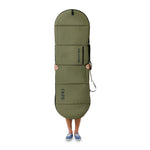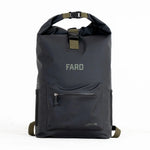Every sport costs some amount, and surfing is no different. How expensive surfing can be depends on a number of factors, including location, equipment, experience, and much more. In this piece, we'll break down all the surfing-related expenses, from lessons to gear costs, accessory expenses, and maintenance. Let's get started.
Diving In
Surfing is a whole new world of excitement and freedom. The feeling of gliding across the water, connecting with nature, and challenging yourself in every wave is unparalleled. Whether you're a beginner or looking to improve your skills, surfing offers something for everyone.
The first step is finding the right spot to learn and practice. Look for beginner-friendly beaches with smaller waves and friendly locals who can offer guidance and support.
Remember that surfing is a sport that requires patience, perseverance, and a willingness to embrace failure as part of the learning process. Don't get discouraged if you fall off your board multiple times – it's all part of the fun!
Surfing Lessons
Surfing lessons are the perfect way to kickstart your surfing journey. Taking lessons from experienced instructors can genuinely make a difference.
Learning to paddle out, pop up on your board, and navigate the waves requires practice and guidance. With personalized feedback from instructors, you'll be hanging ten in no time.
These lessons not only teach you technique but also important safety tips for enjoying the ocean responsibly. Understanding wave dynamics, rip currents, and proper etiquette in the lineup is essential for a fulfilling surfing experience.
There are a lot of places that offer surfing lessons at various price points and with different packages. Surfing lessons for a single individual can cost you anything between $60 to $200, depending on your location, experience, and how long the lessons run.
Gear Costs
Surfing may seem like a simple sport that just requires a board and some waves, but there are various expenses involved in taking up this activity.
1. Surfboard
Buying a surfboard is an unconditional part of the sport. The price you pay will greatly vary depending on the type of board you buy.
Surfboards come in many shapes, sizes, and materials, all influencing the board's price.
You can expect to pay anything between $200 to $1200 for a brand-new surfboard. As a beginner, spending a lot on your first surfboard may be a great loss. Invest in expensive boards and experiment with different types and designs until you find the best surfboard that suits your surfing style. Getting a second hand surfboard is also a great choice.
2. Wetsuit
Buying a wetsuit depends on where you live. If you live in the tropics, you may not need a wetsuit. But if you're going to be surfing in colder waters, having a wetsuit on becomes a necessity.
For milder conditions, entry-level wetsuits made from neoprene can be purchased for around $50 to $150, delivering basic thermal protection.
A mid-range wetsuit with 3mm to 4mm thickness can cost between $150 to $300, suitable for moderate to cold water temperatures.
Top-of-the-line wetsuits from prominent brands may range from $300 to $500 or more, offering advanced features such as seamless construction, thermal lining, and improved flexibility.
3. Fins
Fins are important in helping surfers maneuver through waves with ease and precision. They provide stability and control while riding a wave, allowing surfers to turn smoothly and maintain their balance.
There are different types of fins available on the market, each designed for specific surfing styles and conditions. From single fins to thrusters or quads, choosing the right fin setup can enhance your overall surfing experience.
While there are budget-friendly options available, splurging on premium fins can make a considerable difference in your surfing ability.
4. Surfboard Wax
Applying surfboard wax is a common practice among surfers. It may seem like a small detail, but it plays a big role in helping you stay on your board while riding the waves.
Surfboard wax creates traction between your feet and the board, preventing slips and falls when maneuvering on the water. Without it, you might struggle to maintain your balance on the board.
There are different types of surfboard waxes available, each suited for specific water temperatures. Choosing the right wax for the conditions can enhance your overall surfing experience.
Make sure to regularly check and reapply wax as needed to ensure optimal grip while out on the waves.
5. Surfboard Bags
It's important to keep your surfboards safe during transit. High-quality surfboard bags are designed with surfers in mind, providing durability and protection for your board. Whether you're heading to the beach or traveling long distances, having a reliable surfboard bag is necessary.
FARO Surfboard bags come in various sizes and styles to accommodate different types of boards. From shortboard bags to longboard bags, there's something for every surfer's needs. The padded interior ensures that your board stays safe from dings and scratches during transportation.
Not only do FARO Surfboard bags offer top-notch protection, but these surfboard protectors also make carrying your board hassle-free. With comfortable straps and easy-to-use zippers, these bags are designed for convenience on the go.
Investing in a quality surfboard bag like FARO is not just about protecting your gear; it's about peace of mind, knowing that your board is safe and secure even in the off-season.

Travel Costs
Traveling to different surf spots can be an exciting part of the surfing experience, but it's essential to consider the associated costs. From gas money for driving to nearby beaches or flights and accommodation for more distant destinations, travel expenses can add up quickly.
You don't have to worry about these costs if you live near the coast. However, If you're planning a surf trip, research affordable lodging options like hostels or campgrounds near the beach to save on accommodation costs. Carpooling with friends or fellow surfers is another way to cut down on transportation expenses and make the journey more fun.
Some surf spots may require permits or entrance fees, so factor these additional costs into your budget. Planning ahead and setting a realistic spending limit will help you enjoy your surfing adventures without breaking the bank.
Board Maintenance
Keeping your board in top condition not only ensures optimal performance but also extends its lifespan.
After each surf session, make sure to rinse your board with fresh water to remove any salt or sand particles that could cause damage over time. Inspect the board regularly for any dings or cracks that may need repair.
Spending money on surfboard maintenance may sound like a drag, but it works wonders in prolonging your surfboard lifetime. Here's a list of equipment you will need to keep your surfboard in top shape:
-
Surfboard Repair Kit: A repair kit is indispensable for fixing dings, cracks, or punctures on your surfboard. These kits typically contain resin, catalyst, fiberglass cloth, sandpaper, mixing cups, and applicator sticks. A basic repair kit can cost you around $9 to $50, depending on the quality and quantity of materials included.
-
Sandpaper: Sandpaper is used for smoothing rough surfaces, removing old wax, and preparing the board for repairs. A pack of assorted sandpaper sheets can be purchased for as little as $5.
-
Surfboard Wax Comb: A wax comb comes into play when removing old wax from the board and applying new wax. These combs are usually inexpensive, ranging from $2 to $8.
-
Fin Key: A fin key is necessary for tightening or adjusting fins on your surfboard. This small tool is commonly priced at around $5 to $10.
-
Sun Cure Resin: Sun cure resin is a quick and convenient solution for minor ding repairs that can be done in direct sunlight. A tube of sun cure resin is typically priced at $20 to $50 and is recommended for on-the-go fixes.
Consider getting professional maintenance services done periodically to check for any hidden issues affecting your surfing experience. Taking care of your surfboard will ultimately enhance your overall surfing enjoyment.
Insurance
Surfing can sometimes lead to injuries or damage to your gear, which is why having insurance coverage specifically tailored for surfers can provide peace of mind. While this may add another cost to your surfing expenses, it's an important investment in protecting yourself and your equipment.
There are a few different types of insurance that surfers may want to consider:
-
Health Insurance: Surfing can be a physically demanding sport, and injuries can occur. Health insurance can help cover the costs of medical treatment in case of accidents or injuries while surfing.
-
Travel Insurance: If you plan on taking a surfing trip to another country, having travel insurance is crucial. This coverage can help with unexpected expenses such as lost or damaged equipment, canceled flights, or medical emergencies.
-
Surfboard Insurance: Your surfboard is one of your most valuable pieces of equipment, and it's important that you protect it from damage or theft. Some insurance companies offer specific surfboard policies that cover repairs or replacement in case of damage or loss.
When applying for insurance, be sure to do your research and compare policies from different companies to find the best coverage for your needs and budget. Additionally, check if your homeowner's insurance includes any coverage for your surf gear.

Conclusion
Now that you have a breakdown of all the costs of surfing, you can make a better decision. The initial price may shock you, but you need to remember that this is only an initial investment and will last you for a long time. There are many ways you can save up and make the right purchases. Finding a balance that fits your budget and needs is essential!





